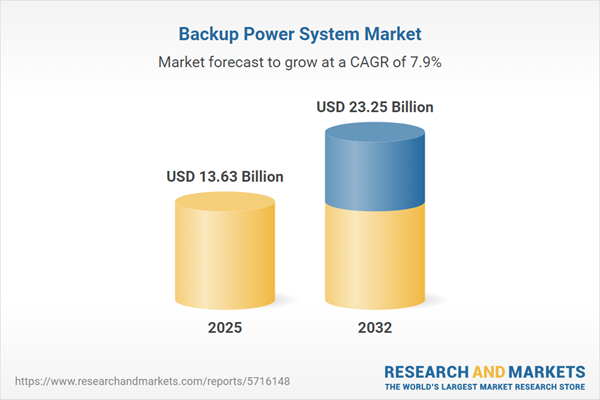Speak directly to the analyst to clarify any post sales queries you may have.
As organizations navigate a landscape marked by operational challenges and shifting regulations, ensuring continuity and energy resilience is now a critical priority. The backup power system market gives senior decision-makers the tools to mitigate business disruption, support compliance, and accelerate digital transformation in rapidly evolving sectors.
Market Snapshot: Backup Power System Market
The backup power system market is showing robust and sustained growth, with enterprises prioritizing investments in reliable energy infrastructure. This trend is particularly apparent in data centers, manufacturing, and mission-critical environments where operations must not falter. Organizations are increasingly aligning infrastructure with rising demands for digitalization and resilience, supported by innovations that help comply with evolving safety standards and adapt to policy changes. As procurement and deployment tactics shift in response to global supply dynamics, companies seek versatile solutions that precisely address specific operational requirements across industries.
Scope & Segmentation
- System Types: Encompasses a comprehensive range of backup solutions, such as battery energy storage (lead-acid, lithium-ion chemistries), fuel cells, diesel and gas generators, and uninterruptible power supplies across online, standby, and line-interactive designs.
- Applications: Targets critical functions, including peak shaving to manage energy costs, continuous prime power for essential operations, and reliable standby backup that reduces unplanned downtime.
- End-Users: Serves a broad range of sectors, from commercial environments like data centers and retail to industrial settings such as oil and gas, manufacturing, mining, and telecommunications, as well as residential markets with a growing interest in system reliability and smart compatibility.
- Regional Coverage: Covers major commercial hubs and emerging markets across the Americas, Europe, the Middle East, Africa, and the Asia-Pacific region—supporting infrastructure resilience in diverse localities, from advanced economies to developing regions.
- Technology Landscape: Focuses on ongoing advancements, including modern battery chemistry, digitally controlled generators, the integration of hybrid models with renewable sources, expanding fuel cell use, and the adoption of predictive maintenance to enhance overall system uptime and reliability.
- Competitive Review: Highlights market strategies by leading vendors adapting to evolving requirements, such as ABB, Caterpillar, Siemens, Huawei, Eaton, Schneider Electric, Toshiba, and more—emphasizing comprehensive product portfolios and flexible deployment models.
Key Takeaways for Senior Decision-Makers
- Strategic investment in backup power drives greater operational efficiency, supports sustainability efforts, and meets diverse organizational specifications through tailored solutions.
- Hybrid systems that combine advanced battery technologies and renewables allow organizations to achieve sustainability milestones while also optimizing cost over the long term.
- By deploying remote monitoring and predictive analytics, enterprises improve system oversight and proactively manage maintenance, reducing operational risk and unexpected downtime.
- Flexible backup strategies adapted for commercial, industrial, and residential needs help businesses ensure continuous uptime and organizational agility.
- Providers offering modular products and service-driven approaches can quickly address shifting market and customer demands, which is essential for growth in both established and emerging segments.
Tariff Impact: Shifts in U.S. Trade Policy
Recent changes in U.S. trade policy have increased the cost of procuring batteries, generator parts, and power conversion units. In response, organizations are diversifying suppliers and creating nearshoring or domestic partnerships to reduce exposure to supply chain risk. The adoption of adaptive procurement strategies and advanced scenario planning enable businesses to maintain consistent pricing even as regulatory and market landscapes evolve. These measures help ensure ongoing access to critical backup system components without disruption.
Methodology & Data Sources
This analysis combines thorough secondary research with detailed interviews to capture a broad spectrum of industry insight. Segmentation, validation, and data triangulation leverage advanced modeling, providing senior decision-makers with reliable guidance for evaluating backup power investments.
Why This Report Matters
- Access actionable insights into how regulatory changes and evolving supply chains impact backup power system procurement and capital planning.
- Identify opportunities for strategic growth in targeted regions or sectors based on technology trends and policy drivers.
- Equip your organization to navigate shifts in sustainability requirements and digital enablement, fostering ongoing resilience and competitiveness.
Conclusion
This report delivers strategic analysis and practical guidance to inform investment in backup power systems. Use these insights to enhance resilience and position your organization for future growth as the industry continues to transform.
Additional Product Information:
- Purchase of this report includes 1 year online access with quarterly updates.
- This report can be updated on request. Please contact our Customer Experience team using the Ask a Question widget on our website.
Table of Contents
3. Executive Summary
4. Market Overview
7. Cumulative Impact of Artificial Intelligence 2025
List of Figures
Samples

LOADING...
Companies Mentioned
The key companies profiled in this Backup Power System market report include:- ABB Limited
- AEG Power Solutions B.V.
- Atlas Copco AB
- Bon Pty Ltd.
- Briggs & Stratton Corporation
- Caterpillar Inc.
- CyberPower Systems, Inc.
- Delta Electronics, Inc.
- Eaton Corporation PLC
- Emerson Electric Co.
- Exide Industries Limited
- Fuji Electric Co., Ltd.
- General Electric Company
- HIMOINSA SL
- Huawei Technologies Co., Ltd.
- Kohler Co.
- Legrand S.A.
- Magellan Power
- Microtek International Pvt Ltd.
- Mitsubishi Electric Corporation
- Schneider Electric SE
- Siemens AG
- Su-Kam Power Systems Ltd.
- Toshiba Corporation
Table Information
| Report Attribute | Details |
|---|---|
| No. of Pages | 187 |
| Published | October 2025 |
| Forecast Period | 2025 - 2032 |
| Estimated Market Value ( USD | $ 13.63 Billion |
| Forecasted Market Value ( USD | $ 23.25 Billion |
| Compound Annual Growth Rate | 7.9% |
| Regions Covered | Global |
| No. of Companies Mentioned | 25 |









